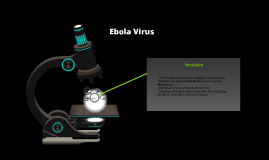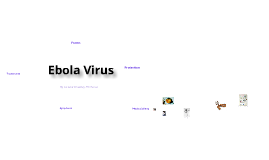Ebola Virus
Transcript: Ebola Virus Forms There are five forms of Ebola virus known to us. They are Ebola-Zaire, Ebola-Sudan, Ebola-Ivory Coast, Ebola-Reston, and Ebola-Bundibugyo (graphic aid). Ebola-Sudan is known for being very hot, or spreadable, with a lethality rate of 53% in 2001. (unreliable source/fact opinion) Ebola-Ivory Coast is also known as Tai Forest virus. It has a lower lethality rate and there has been only one known outbreak, in Tai Forest. Ebola-Reston is only found in nonhuman primates and occasionally pigs. It does not manifest symptoms in humans. Ebola-Zaire is one of the most commonly occuring forms of Ebola (table). Its overall lethality is 83% (Wikipedia). Ebola-Bundibugyo (THAT'S a fun word to say) is the newest form of Ebola, discovered in 2007 in Bundibugyo, Uganda (table). Its lethality rate is (predicted) about 34% (Wikipedia). Treatments At this time, there is no FDA-Approved treatment for Ebola virus (TSO). However, there was a study on how a near-lethal Ebola injection creates a response. after recombinant nematode anticoagulant protein c2 (rNAPc2) is injected. (Venn Diagram) (Before you ask, no, I am not entirely sure what recombinant nematode anticoagulant protein c2 is. Ask Peter Jahrling what it is.) Apparently rNAPc2 prolonged the macaques' survival. There was a 33% suvival rate, and those that did survive were still alive and healthy after 9 months. (magazine) With rNAPc2, perhaps there is hope for treating Ebola! Protection As of today, Ebola virus has no identifed source in nature. HOWEVER! Don't get panicky yet, because scientists do have hypotheses as to where it does come from. Contact with nonhuman primates, bats, or other Ebola virus risk factors is not to be encouraged. Ebola is native to Africa (skim and scan), so be careful handling any monkey (cause and effect) from any part of Africa. If you do decide to work with Ebola in the lab, be sure to wear protective suits and use Biosafety Level-4 containment. Do not handle Ebola if you do not have this level of training! If you have the misfortune to be in Africa during an outbreak, avoid the use of dirty needles. These will spread around the virus like NO TOMORROW. Not-so-fun Fact: The reason why African hospitals use dirty needles is because they do not have the money to get new ones (Treatment, Scope, Organization). Advise all medical staff to use barrier nursing, and discourage traditional burial embalmings or traditions involving the dead body. Whatever you do, do NOT. EVER. TOUCH. a dead Ebola body. Avoid direct skin-to-skin contact, or contact with bodily fluids. And above all, if you yourself become ill, please, don't touch anyone, breathe on anyone, puke on anyone, bleed on anyone, or resist medical treatments in any way. Symptoms Ebola is clinically indistinguishable from Marburg (cause and effect), another Filovirus, and several other hemorrhagic fevers. The incubation period, or time from infection until you begin showing symptoms, is about 12.7 days (skim and scan). Ebola begins like influenza, symptoms including fever, chills, muscle pain, joint pain, chest pain, and general discomfort. Nausea, abdominal pain, vomiting, diarrhea, and anorexia (not eating) follow. Breathlessness, sore throat, coughing, and hiccups also occur. The nervous system is also afflicted, with agitation, fatigue, headache, confusion, depression, seizures, and in some cases, coma. Ebola damages the brain and causes psychotic dementia (fact opinion). Despite having the name "hemorrhagic fever", those kinds of symptoms are infrequent, with most symptoms of this kind being bloody vomit, bloody coughing, black feces, nosebleed, vaginal bleeding, bleeding gums, bleeding from pores, and bleeding from ears. However, bleeding occurs more under the skin rather than out of it. Petechial symptoms include bruising, purpura (red or purple discolorations on skin), maculopapular rash (red area with raised bumps), and hematoma (a localized collection of blood outside blood cells). Some reasons why someone could die from Ebola would be organ failure, blood loss, or dehydration (they would lose water puking). Photo Gallery No, ladies and gentlemen, the fun did not stop there! Thanks for watching! an example of bleeding pores For those with weak stomachs: doctors treating an ebola patient I would advise looking away until I say you can look again. It's... slightly unnerving. Ebola virus magnified By Cordelia Wheatley, 7th Period Ebola microbe plushie!!! an Ebola virus warning sign in the Democratic Republic of the Congo.

















